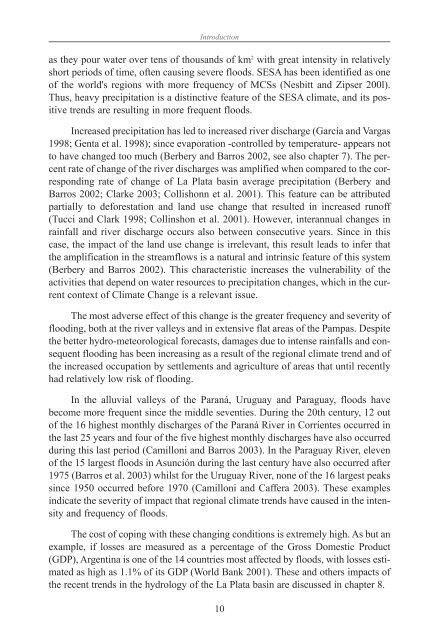chapter - Atmospheric and Oceanic Science
chapter - Atmospheric and Oceanic Science
chapter - Atmospheric and Oceanic Science
Create successful ePaper yourself
Turn your PDF publications into a flip-book with our unique Google optimized e-Paper software.
Introduction<br />
as they pour water over tens of thous<strong>and</strong>s of km 2 with great intensity in relatively<br />
short periods of time, often causing severe floods. SESA has been identified as one<br />
of the world's regions with more frequency of MCSs (Nesbitt <strong>and</strong> Zipser 200l).<br />
Thus, heavy precipitation is a distinctive feature of the SESA climate, <strong>and</strong> its positive<br />
trends are resulting in more frequent floods.<br />
Increased precipitation has led to increased river discharge (García <strong>and</strong> Vargas<br />
1998; Genta et al. 1998); since evaporation -controlled by temperature- appears not<br />
to have changed too much (Berbery <strong>and</strong> Barros 2002, see also <strong>chapter</strong> 7). The percent<br />
rate of change of the river discharges was amplified when compared to the corresponding<br />
rate of change of La Plata basin average precipitation (Berbery <strong>and</strong><br />
Barros 2002; Clarke 2003; Collishonn et al. 2001). This feature can be attributed<br />
partially to deforestation <strong>and</strong> l<strong>and</strong> use change that resulted in increased runoff<br />
(Tucci <strong>and</strong> Clark 1998; Collinshon et al. 2001). However, interannual changes in<br />
rainfall <strong>and</strong> river discharge occurs also between consecutive years. Since in this<br />
case, the impact of the l<strong>and</strong> use change is irrelevant, this result leads to infer that<br />
the amplification in the streamflows is a natural <strong>and</strong> intrinsic feature of this system<br />
(Berbery <strong>and</strong> Barros 2002). This characteristic increases the vulnerability of the<br />
activities that depend on water resources to precipitation changes, which in the current<br />
context of Climate Change is a relevant issue.<br />
The most adverse effect of this change is the greater frequency <strong>and</strong> severity of<br />
flooding, both at the river valleys <strong>and</strong> in extensive flat areas of the Pampas. Despite<br />
the better hydro-meteorological forecasts, damages due to intense rainfalls <strong>and</strong> consequent<br />
flooding has been increasing as a result of the regional climate trend <strong>and</strong> of<br />
the increased occupation by settlements <strong>and</strong> agriculture of areas that until recently<br />
had relatively low risk of flooding.<br />
In the alluvial valleys of the Paraná, Uruguay <strong>and</strong> Paraguay, floods have<br />
become more frequent since the middle seventies. During the 20th century, 12 out<br />
of the 16 highest monthly discharges of the Paraná River in Corrientes occurred in<br />
the last 25 years <strong>and</strong> four of the five highest monthly discharges have also occurred<br />
during this last period (Camilloni <strong>and</strong> Barros 2003). In the Paraguay River, eleven<br />
of the 15 largest floods in Asunción during the last century have also occurred after<br />
1975 (Barros et al. 2003) whilst for the Uruguay River, none of the 16 largest peaks<br />
since 1950 occurred before 1970 (Camilloni <strong>and</strong> Caffera 2003). These examples<br />
indicate the severity of impact that regional climate trends have caused in the intensity<br />
<strong>and</strong> frequency of floods.<br />
The cost of coping with these changing conditions is extremely high. As but an<br />
example, if losses are measured as a percentage of the Gross Domestic Product<br />
(GDP), Argentina is one of the 14 countries most affected by floods, with losses estimated<br />
as high as 1.1% of its GDP (World Bank 2001). These <strong>and</strong> others impacts of<br />
the recent trends in the hydrology of the La Plata basin are discussed in <strong>chapter</strong> 8.<br />
10






